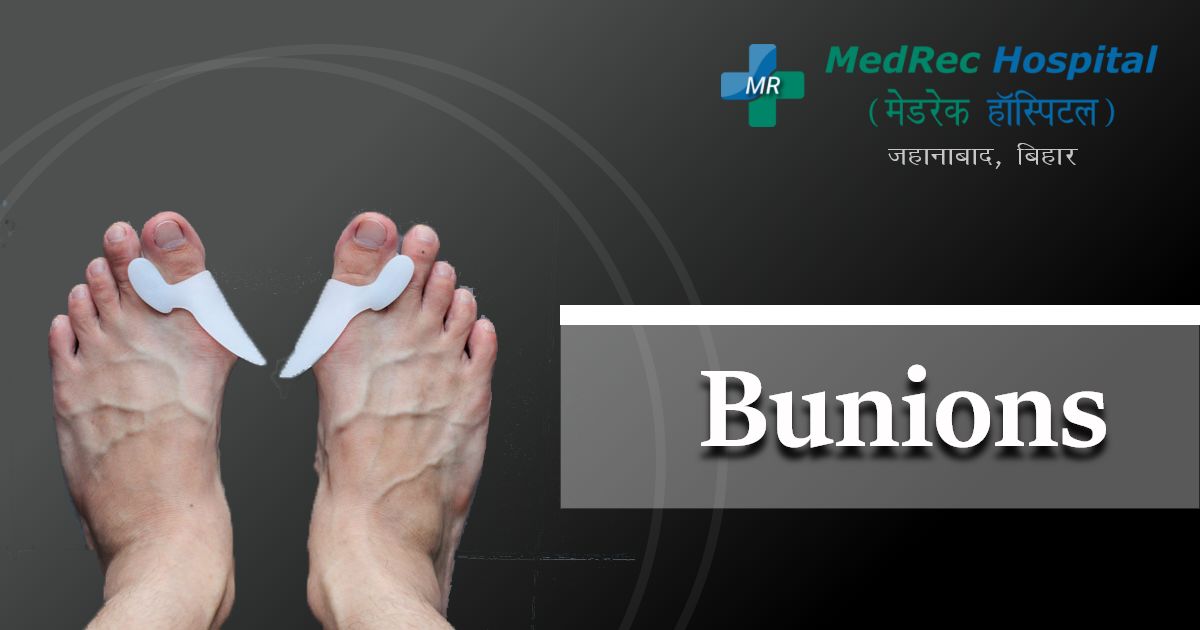
Bunions : Risk Factors, Complication, Prevention & Treatment
781
A bony growth that forms on the big toe joint is known as a bunion. It happens when a few of the bones in your foot's front move out of place. The joint at the base of your big toe is forced to protrude because the tip of your big toe is being tugged toward your smaller toes. The skin over the bunion may be inflamed and painful.
Wearing tight, narrow shoes increase your risk of developing or aggravating bunions. A foot deformity, the shape of your foot, or a medical condition like arthritis can also cause bunions.
Smaller bunions may start to form at the joint of your little toe.
Causes
Although the precise cause of bunions is uncertain, there are numerous ideas on how they arise. Probability factors include:
- Inherited type of feet
- Injury or stress on the feet
- The presence of birth defects
- There is debate among experts as to whether bunions are directly caused by tight, high-heeled, or too-narrow shoes or if bunions are just a result of this footwear.
Certain kinds of arthritis, especially inflammatory types like rheumatoid arthritis, may be linked to bunions.
How to check if you have Bunions?
Visit your doctor who focuses on treating foot disorders (a podiatrist or orthopaedic foot specialist), even though bunions frequently do not need medical attention. If you have:
- Persistent foot or big toe aches
- A noticeable lump on the joint of your big toe
- Reduced big toe or foot movement
- A bunion makes it difficult to find shoes that fit properly.
Risk Factors
Your risk of bunions may be increased by the following:
Tall heels. Your toes may become crowded when wearing high heels since they force them into the front of your shoes.
Uncomfortable shoes. Bunions are more likely to form on those who wear shoes that are overly thin, tight, or pointed.
Rheumatoid Arthritis. The likelihood of developing bunions may increase if you have this inflammatory illness.
Heredity. It is possible that an inherited issue with the structure or anatomy of your foot is the cause of your propensity to develop bunions.
Symptoms
The following list of symptoms are indicators of a bunion:
- A protruding mass on the outside of the base of your big toe
- Swelling, erythema, or pain near the big toe joint
- Suffering that is ongoing or repetitive
- Corns or calluses are typically developed where the first and second toes brush against one another
Prevention
Pick your shoes wisely to help prevent bunions. There should be room between the tip of your longest toe and the end of the shoe, and they should not have sharp toes.
Without pinching or squeezing any portion of your foot, your shoes should mould to the shape of your feet.
Treatments
Depending on how painful your bunion is and how severe it is, there are many treatment options.
Traditional treatment
The following nonsurgical procedures could ease the discomfort and pressure caused by a bunion:
Altering shoes. Put on comfy, roomy shoes that give your toes plenty of room.
Padding. Bunion pads or cushions sold over the counter without a prescription might be beneficial. They can reduce pain by serving as a cushion between your foot and the shoe.
Medications. You can manage the pain of a bunion by taking acetaminophen (Tylenol, other), ibuprofen (Advil, Motrin IB, other), or naproxen sodium (Aleve). Cortisone injections might also be beneficial.
Sock liners. When you move your feet, padding in your shoes can help distribute pressure properly, easing your symptoms and keeping your bunion from getting worse. Buying supports off-the-shelf can help some people; prescription orthotic devices are needed for others.
Putting ice on. After being on your feet for an extended period of time or if it becomes inflamed, applying ice to your bunion can help reduce pain and swelling. Before applying ice to your feet, check with your doctor if you have decreased sensation or circulation issues.
Operative choices
You may require surgery if conservative treatment is ineffective in treating your symptoms. Only when a bunion gives you persistent pain or interferes with your everyday activities is surgery advised; not for cosmetic reasons.
There are numerous surgical treatments for bunions, and there is no one method that works best for all conditions.
Bunions can be treated surgically with a single treatment or a series of procedures. They could include:
- Removing the puffy skin from your big toe joint's vicinity
- By removing a portion of the bone, you can straighten your big toe.
- To fix the aberrant angle in your big toe joint, realign one or more forefoot bones to a more typical position.
- Permanently fusing the bones of your troubled joint
After healing, you will need to wear the right shoes to avoid a recurrence. Expecting most people to wear narrow shoes after surgery is unrealistic.
Consult your doctor to learn what to anticipate following bunion surgery.
Complications of Bunions
The following are potential complications of bunions:
Bursitis. The tiny fluid-filled pads that cushion the bones close to your joints become inflamed, resulting in this uncomfortable ailment.
Hammertoe. Pain and pressure can result from an irregular bend in the middle joint of a toe, typically the toe adjacent to your big toe.
Metatarsalgia. Your foot's ball will ache and swell as a result of this ailment.
For further information please access the following resources:
Emergency : +91 89686 77907
Front Desk : +91 98018 79584
Page last reviewed: Mar 13, 2023
Next review due: Mar 13, 2025







.jpg)
.jpg)
.jpg)
.jpg)
.jpg)
.jpg)